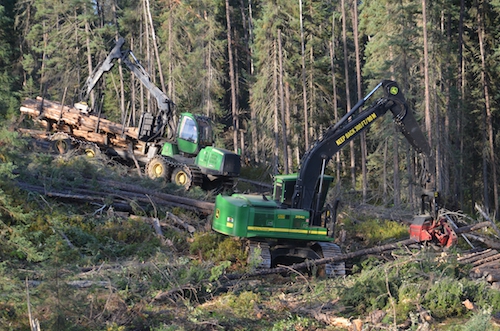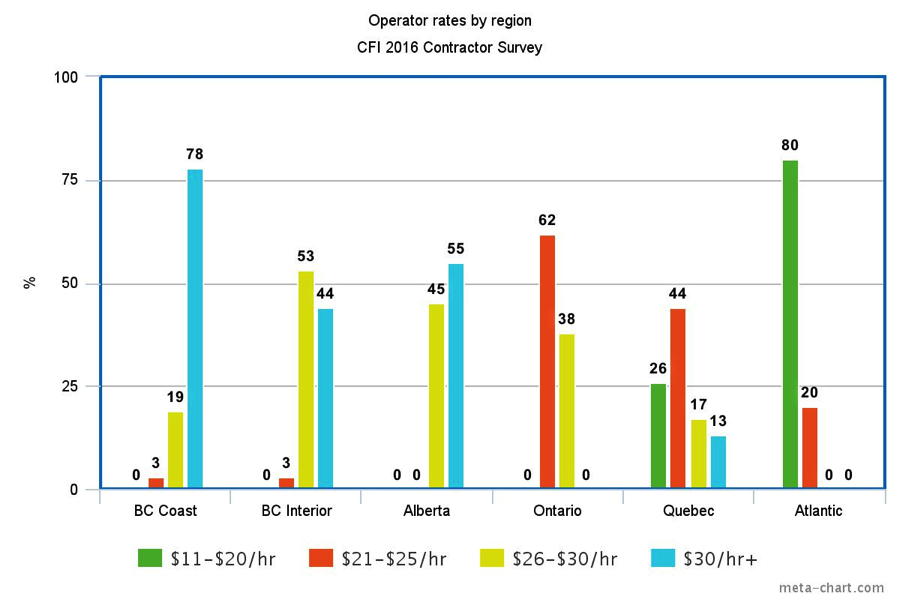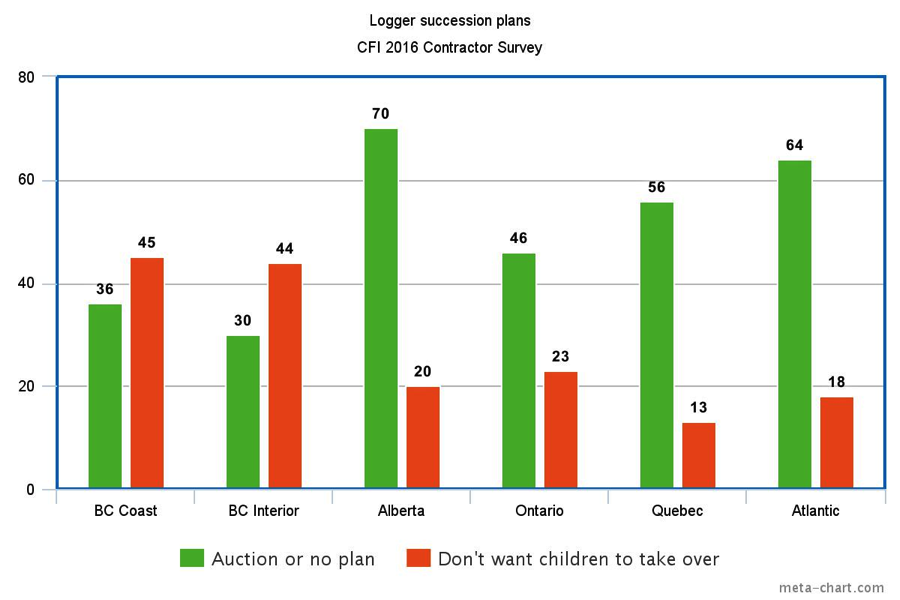
Features
Harvesting
Logging Profiles
Ontario loggers report tough conditions
Oct. 31, 2016 - Turnover among contractors in Ontario, especially very large contractors, has been significant in the past decade, and our survey may have insight as to why. In general, Ontario contractors reported the following:
October 31, 2016 By Scott Jamieson

Rates and profits
Based on the results of Canadian Forest Industries’ 2016 Contractor Survey, just 41 per cent of all contractors saw some form of rate increase over the past three years. For the majority, rates were either stagnant (28%) or had declined somewhat (23%), with 8 per cent preferring not to say.
While Ontario fared better than Quebec (17%) or Atlantic Canada (23%) in being able to negotiate rate increases, they did noticeably worse than the average and contractors to their west, with just 31 per cent seeing a rate increase over the past three years.
Stagnant rates are especially bad news in Ontario, as the profit picture here was already poor. Almost a third (31%) saw no profit at all in 2015, at least 50 per cent higher than all other regions as far as the number of loggers just hanging on. On the other hand, another third saw profits between six and 10 per cent, also significantly higher than other regions except the BC Interior.
Operator pay
Not surprisingly, operator rates are noticeably higher in Ontario than in Quebec and Atlantic Canada, but also noticeably lower than those further west. Almost two-thirds (62%) make between $21/hour and $25/hour, with the rest making between $26/hour and $30/hour. Unlike Quebec however, no Ontario logger reported operator pay above $30/hour.
Trends in operator benefits followed closely, with 54 per cent stating they paid some form of benefits, compared to over 90 per cent in BC and 44 per cent in Atlantic Canada. Benefits include medical/dental (46%), life insurance (31%), paid vacation beyond legal minimum (31%) and matching pensions (23%).
For comparison to the general economy, 65 per cent of Ontario workers have medical/dental benefits, with those left out typically thought of as low-income or “precarious” workers. Given that, the industry has some ground to make up on this front to be a competitive employer.
Workload
Despite this gloomy profit and wage picture, contractors in Ontario tend to work the longest hours in the country, with 77 per cent claiming to work over 55 hours per week. That puts them in good company with the BC Interior (75%) and Alberta (73%), and compares to 56 per cent on the Coast, 63 per cent in Atlantic Canada, and 38 per cent in La Belle Province, one band of sanity across the nation when it comes to a work-life balance.
That work/life balance is out of whack with most of the general economy, and will likely be a hurdle when attracting the next generation of logging contractors in many of these regions.
Company size
Along with their colleagues in the BC Interior, Ontario contractors have the largest fleets and harvest volumes. Ontario also tends to have the most “super fleet” contractors, with almost one-third (31%) reporting fleets of 51 to 100 machines (19% in the BC Interior). Just over half (54%) claim fleets in the 21- to 50-machine range, almost identical to the BC Interior (53%). Only loggers in BC own more pick-up trucks, with 38 per cent of Ontario contractors owning 11 to 20 pick-ups and 8 per cent owning more than 20.
These fleet sizes will also likely have an impact on succession planning, as the larger the fleet, the higher the cost of entry for the next gen of contractors. Barriers to entry appear to be far lower in Quebec and Atlantic Canada than anywhere west of Montreal.
More than half (54%) of Ontario contractors have 21 or more employees, higher than the national average of 46 per cent and much higher than Quebec (13%) and Atlantic Canada (16%). Overall, these are not simple operations to acquire or learn how to run.
Only 15 per cent of Ontario contractors earn more than $5 million in revenue, while almost a third (31%) earn from $2 million to $5 million. This puts them well above their colleagues to the east and well below those to the west.
Mill consolidation
Loggers are generally faced with fewer and fewer mills to sell their products and services to, a general concern that affects some regions more than others. Ontario fares relatively well when it comes to the number of mills potentially buying fibre in their regions. Over two thirds (71%) of contractors in Ontario report that there are four or more mills in their region.
In reality, just 38 per cent of Ontario loggers sell to four or more mills, however only 31 per cent sell to two or less, compared to 40 per cent in Atlantic Canada, 48 per cent in Quebec, 60 per cent in Alberta, 56 per cent on the BC Coast and a whopping 75 per cent in the BC Interior.
Perhaps more telling is that just 8 per cent report selling to just one mill, by far the lowest monopoly status in Canada. In Ontario at least there seems to be little correlation between mill consolidation and contractor health.
Contractor age
Ontario contractors are among the oldest in Canada, with almost half (46%) being 56 years old or more. Only the BC Coast has nearly as many elder statesmen (44%). Another large chunk sits in the 36- to 55-year-old band (36%), with half that in the under-35 range (18%). That is far older than Quebec’s loggers, where just 32 per cent of loggers are 46 and older, and 42 per cent are under 35.
The next generation
That age breakdown, as well as retirement plans, makes succession planning a possible nightmare in Ontario. Almost two thirds (61%) expect to be in the industry for fewer than 10 years, bested only by the BC Coast (66%), but similar to Alberta (60%) and the BC Interior (58%).
Yet there is some time to get this right, as just 15 per cent of Ontario contractors expect to leave the sector within five years, much lower than all regions except Atlantic Canada (18%).
Another positive is that 46 per cent have some form of succession plan involving children or staff, the highest incidence in the country, and only 23 per cent are adamant that they do not want their children taking over, much lower than in BC. On the other hand, 46 per cent have no succession plans at all.
The Canadian Forest Industries 2016 Contractor Survey was conducted in April 2016 for Canadian Forest Industries and Operations forestieres et de scierie by independent research firm Bramm & Associates, generating over 230 replies to a detailed list of questions. Many thanks to our sponsors for making this vital research possible – Hultdins, Stihl, Tigercat and Ponsse, and the Ontario Media Development Corporation.
Print this page